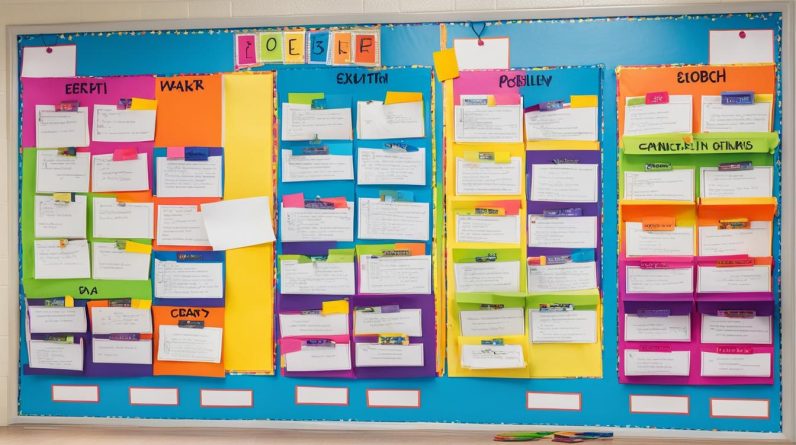Are your kids’ school papers taking over your home? Do you find yourself drowning in a sea of paper clutter? It’s time to take control and establish an effective system for organizing kids’ school papers at home. With a few simple strategies, you can declutter, sort, and store your children’s school papers in a way that is both practical and efficient.
From daily backpack cleanouts to creating display areas for special pieces, this article will provide you with step-by-step guidance on how to organize your kids’ school papers effectively. Say goodbye to lost permission slips and buried report cards—follow our tips and transform your home into a paper organization haven.
Key Takeaways:
- Establish a daily routine for clearing out backpacks and folders to prevent papers from piling up.
- Create a designated display area for your children’s artwork and special papers.
- Set guidelines for what papers to keep and what to discard to prevent overwhelming clutter.
- Consider investing in a school papers organizer to simplify the organization process.
- Create a separate keepsake bin for special papers that hold sentimental value.
The Importance of Having a Paperwork Plan
When it comes to organizing papers for kids, having a solid paperwork plan is key. Without one, you may find yourself drowning in a sea of school papers, struggling to keep track of important documents. By implementing a few tips for organizing school papers at home and creating a clear plan, you can save time, reduce stress, and maintain a clutter-free environment.
So, why is it essential to have a paperwork plan for organizing kids’ school papers? Let’s take a closer look at the benefits:
- Efficient organization: A paperwork plan allows you to establish a systematic approach to organizing and storing your child’s school papers. You can create designated spaces or folders for different types of papers, making it easier to locate specific documents when needed.
- Reduced clutter: By having a plan in place, you can avoid the accumulation of unnecessary papers. You’ll know exactly what to keep and what to discard, preventing piles of papers from taking over your living space.
- Easy access: With a paperwork plan, important documents won’t get lost or misplaced. You’ll have a designated spot for each paper category, making it effortless to find report cards, permission slips, or other important school-related paperwork.
- Follow-through accountability: When everyone in the household is aware of the paperwork plan, it becomes easier to maintain organization. Family members can take responsibility for sorting and filing papers, ensuring that the plan is consistently followed.
Now that you understand the importance of having a paperwork plan, let’s delve into some practical tips for organizing school papers at home.
Step 1 – Clear out Backpacks/Folders Daily
The first step in organizing kids’ school papers is to establish a routine of clearing out backpacks and folders daily. By doing this, you can prevent papers from piling up and create a clutter-free environment in your home. Here are some school paper organization ideas to help you get started.
Create a Daily Paper Sorting System
Designate a specific area in your home where your child can empty their backpack and folders each day. This could be a desk, a table, or even a designated shelf. Encourage them to remove all paperwork from their folders and place them in the designated area.
Decide What to Keep and What to Discard
Once all the papers are out, it’s time to go through them and decide what to keep and what to discard. Organizing children’s schoolwork involves making choices about what is important to keep for reference or sentimental reasons and what can be let go. Consider factors such as the significance of the paper, your child’s attachment to it, and its long-term value.
Pro Tip: Take photos or scan important papers that hold sentimental value but are not practical to keep physically. This way, you can preserve the memory without the clutter.
Create Separate Piles or Folders
Sort the papers into different piles or folders based on their category or purpose. For example, you can have separate piles for artwork, completed assignments, newsletters, or permission slips. This will make it easier to find specific papers when needed and keep everything organized.
Discard or Recycle Unwanted Papers
Once you have sorted and identified the papers to keep, it’s time to discard or recycle the ones you no longer need. This will help reduce clutter and create a clean space for the papers that matter. Consider using a shredder for papers with personal information, such as report cards or progress reports.
Establish a Routine
Make clearing out backpacks and folders a daily habit. Set aside a specific time each day to go through the papers and keep the process consistent. By establishing a routine, you can prevent papers from accumulating and maintain an organized system for managing your child’s school papers.
By following these school paper organization ideas and clearing out backpacks and folders daily, you can keep your home organized and create a stress-free environment for managing your children’s school papers.
Step 2 – Create a Display Area for Special Pieces
Creating a display area for special pieces of children’s artwork or school papers is an effective way to keep the space organized while showcasing your child’s achievements.
Designate a specific area in your house, such as a playroom or hallway, where you can create this display. This will not only provide a designated space for special papers but also serve as a visual reminder of your child’s progress and accomplishments.
By having a designated display area, you can easily rotate out old papers and keep the space clutter-free. Choose a spot where the display will be prominent and easily visible to everyone in your household.
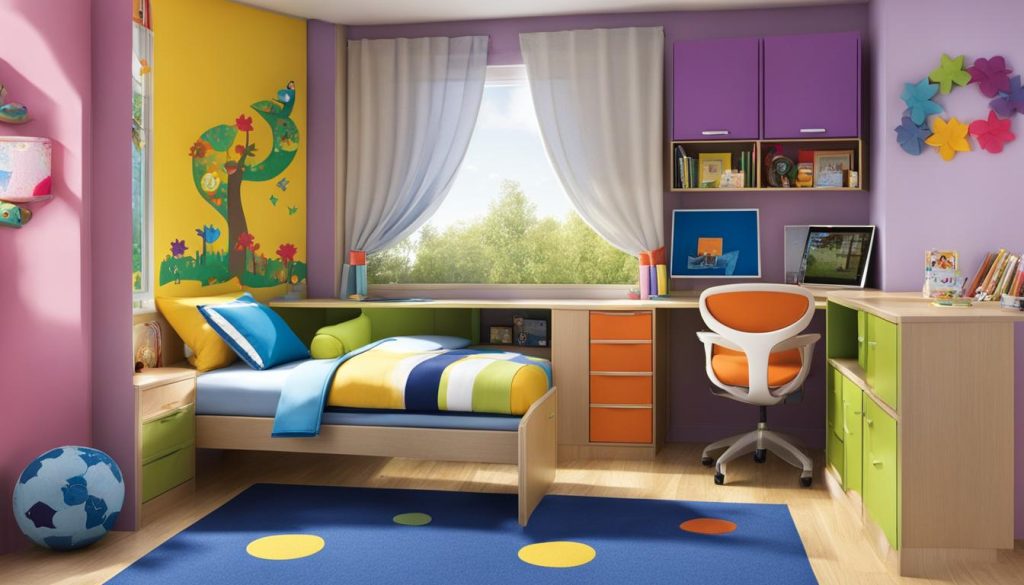
There are various display options to consider. Here are a few ideas:
| Display Option | Description |
|---|---|
| Wall-mounted frames | Hang frames on the wall to showcase your child’s artwork and certificates. Use removable adhesive hooks or a gallery-style hanging system for easy installation and arrangement. |
| Corkboard or bulletin board | Pin up your child’s papers on a corkboard or bulletin board. This allows for easy rotation and adds a decorative touch to the space. |
| Clipboards | Hang clipboards on the wall and attach your child’s papers. This option provides a simple and budget-friendly way to display artwork and important school papers. |
| Art display wires | Install art display wires or clotheslines across a wall and use clothespins or clips to hang your child’s artwork. This creates a whimsical look and allows for easy swapping of papers. |
Remember to regularly update the display area by replacing older papers with new ones. This will keep the display fresh and ensure that you have enough space for new creations and achievements.
Step 3 – Plan for Extra Special “Keepers”
While decluttering kids’ school papers, it’s important to remember that some of these papers hold special meaning and are worth preserving for the long-term. In this step, we will discuss effective strategies for storing and organizing these extra special “keepers” to ensure they are kept safe and easily accessible in the future.
Using a File Box System
One method for organizing these sentimental papers is by using a file box system. This involves creating separate folders for each child and each school year within the file box. Label each folder with the child’s name, school year, and a brief description of the contents. This way, you can easily locate and retrieve specific papers whenever needed.
Creating Separate Folders
Another option is to create separate folders for each child and each school year. Use a filing cabinet, drawer, or storage bin to keep these folders organized. Label each folder with the child’s name, school year, and a description of the contents. This method allows for easy categorization and access to specific papers.
Utilizing a Digital Method
In today’s digital age, using a digital method to store and preserve kids’ special school papers is becoming increasingly popular. Scan or take photos of the papers and store them digitally on a computer or cloud storage. Consider creating separate folders for each child and each school year, just like the physical file system.
Remember to keep backups of digital files to prevent any accidental loss. Additionally, you can create a digital memory book or portfolio to showcase these special papers in a digital format.
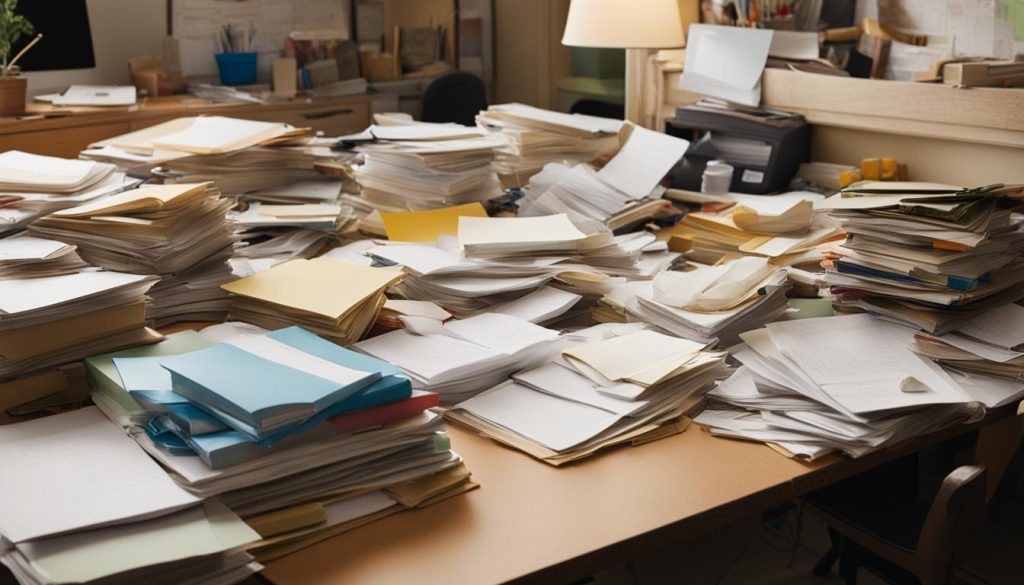
By having a plan in place for organizing and storing these extra special papers, you can maintain a clutter-free environment while cherishing the sentimental value they hold. Whether you choose a file box system, separate folders, or a digital method, finding a solution that works best for you and your family will ensure that these important memories are preserved for years to come.
Tips for Organizing Kids’ Artwork and Memorabilia
When it comes to organizing kids’ artwork and memorabilia, it can be just as challenging as organizing school papers. These precious creations and sentimental items hold special value, and it’s important to have a system in place to preserve them. Here are some effective ways to organize kids’ school papers in a way that keeps them safe and organized:
- Use storage bins and folders: Invest in sturdy storage bins or folders to keep the artwork and memorabilia organized. Label each bin or folder with your child’s name and the date or school year.
- Create a digital portfolio: Take pictures or scan your child’s artwork and create a digital portfolio. You can store these digital files on your computer or in cloud storage. This not only saves space but also allows you to easily access and share your child’s creations with family and friends.
- Rotate displays: If you have limited space for displaying artwork, consider creating a rotating display. Hang a corkboard or use a magnetic board where you can showcase a few pieces of artwork at a time. Periodically switch out the displayed artwork to keep it fresh and prevent clutter.
- Preserve special items: Some artwork or memorabilia may be too large or delicate to store in a bin or folder. Consider investing in special preservation techniques such as framing or laminating to protect these items while still showcasing them.
“Organizing kids’ artwork and memorabilia can be a creative and rewarding experience. By implementing these tips, you can create a system that both preserves your child’s creations and keeps your home clutter-free.”
Remember, each child is unique, and their artwork and memorabilia hold special meaning. Take the time to involve your child in the organizing process and let them choose which pieces are most important to them. By following these effective ways to organize kids’ school papers and artwork, you can create a beautiful and organized collection of memories to cherish for years to come.
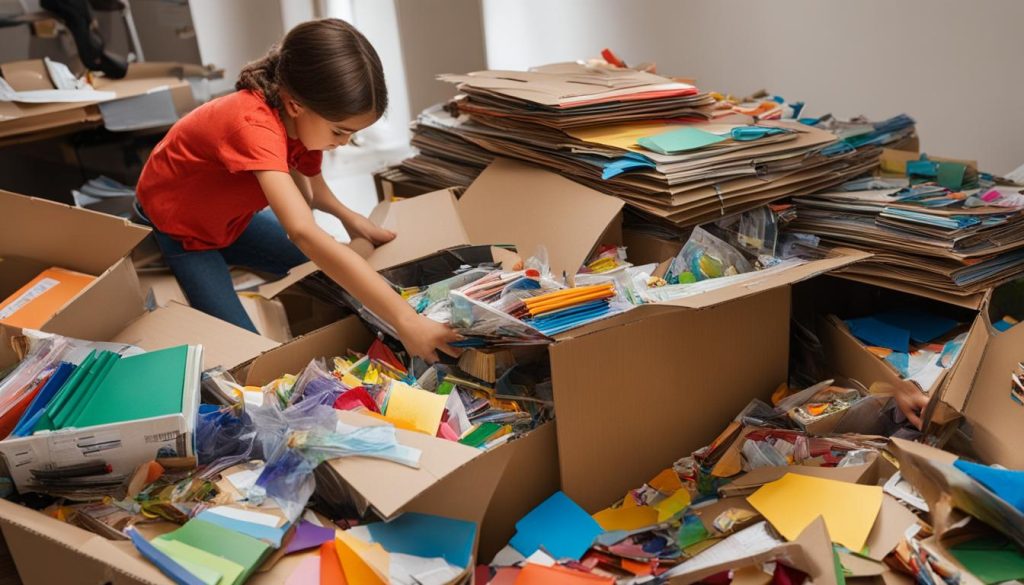
Simplifying the Process with a School Papers Organizer
To simplify the process of organizing your kids’ school papers, investing in a school papers organizer can be a game-changer. These organizers come in various forms, such as portable file boxes or hanging file systems, and provide a designated space for storing and sorting school papers. By utilizing a school papers organizer, you can streamline the organization process and create a more efficient system for managing your children’s papers.
Having a designated place to store school papers not only saves you time and effort but also ensures that important documents are easily accessible when needed. With a school papers organizer, you can create separate sections or folders for different subjects, grades, or school years, making it easier to find specific papers when necessary.
Let’s explore some of the different types of school papers organizers:
- Portable File Boxes: These boxes are compact and easy to carry, allowing you to move your kids’ school papers from one location to another effortlessly. They usually come with built-in handles and can accommodate hanging file folders.
- Hanging File Systems: Hanging file systems are another popular choice for organizing school papers. They consist of a frame with multiple compartments that can hold hanging file folders. Hanging file systems can be mounted on the wall or placed on a desk or shelf for easy access.
- Accordion Folders: Accordion folders are portable and convenient for holding a large number of papers. They typically have multiple pockets or sections that can be labeled for different subjects or grades.
Whichever type of school papers organizer you choose, make sure it suits your specific needs and fits well within your home’s organization system.
“Investing in a school papers organizer can save you from the hassle of searching for important papers and create a sense of order in your home.”
Here is an example of how a hanging file system can be used to organize your kids’ school papers:
| Subject | Grade | School Year |
|---|---|---|
| Math | 3rd Grade | 2021-2022 |
| English | 5th Grade | 2020-2021 |
| Science | 2nd Grade | 2019-2020 |
With a hanging file system, you can allocate a separate hanging file folder for each subject, grade, and school year. This allows you to easily file and retrieve your kids’ school papers based on their specific category. By organizing your school papers in this manner, you can create a systematic and efficient organization system that supports your kids’ academic journey.
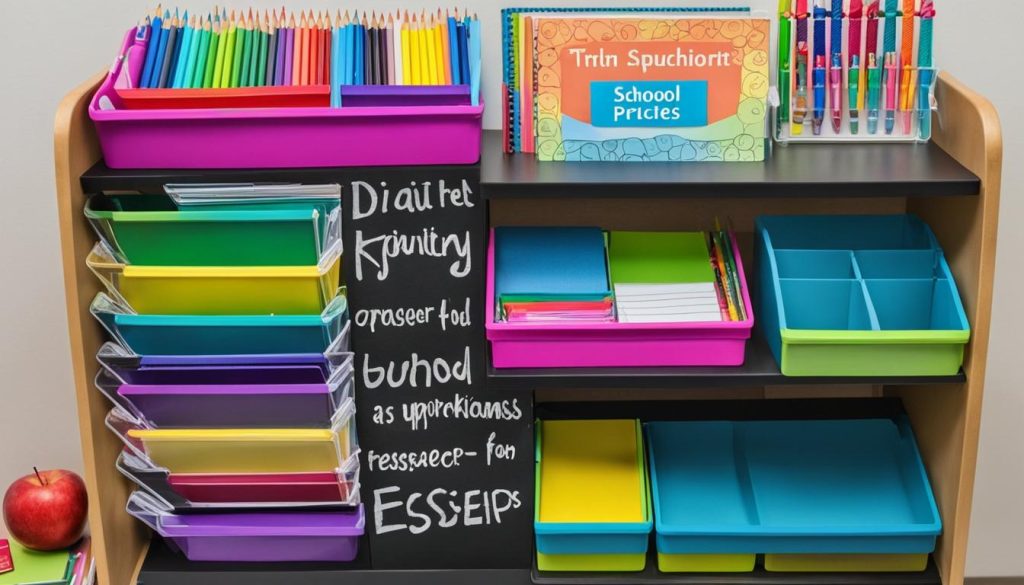
Investing in a school papers organizer is a smart approach to keeping track of your kids’ school papers and maintaining an orderly home environment. By implementing a system that works for your family, you can ensure that important papers are easily accessible and minimize clutter. Say goodbye to the stress of searching for misplaced papers and hello to a more organized and efficient school papers management system.
Setting Guidelines for What to Keep and What to Toss
When it comes to organizing your children’s schoolwork, setting clear guidelines for what to keep and what to toss is essential. This will help you prevent overwhelming clutter and ensure that you only hold onto the most meaningful and important papers. Here are some tips to help you make informed decisions and maintain a streamlined system:
1. Prioritize artwork, certificates, and special projects
One of the key criteria for determining what to keep is the sentimental value of the paper. Artwork created by your child, certificates of achievements, and special projects are all examples of school papers that are worth hanging onto. These papers represent milestones and memories that you and your child will cherish for years to come.
2. Consider the educational significance
Another factor to consider is the educational value of the paper. Look for papers that showcase your child’s growth, academic accomplishments, or demonstrate their understanding of a particular subject. These types of papers can provide insight into your child’s progress and serve as a record of their educational journey.
3. Streamline duplicates and drafts
When organizing your children’s school papers, it’s common to come across duplicates or multiple drafts of the same assignment. While it’s important to acknowledge their effort and progress, it’s not necessary to keep every single version. Consider selecting the best representation and letting go of the rest to reduce clutter.
“Setting guidelines for what to keep and what to toss is a crucial step in maintaining an organized system for your children’s school papers.” – Your Name
By setting guidelines, you can confidently make decisions about what to keep and what to let go of. This will not only maintain a clutter-free environment but also make it easier to find and access important papers when needed. Remember, the goal is to preserve meaningful memories and create a streamlined system that supports your child’s academic journey.
To help you visualize the paper organization process, here’s a table summarizing the guidelines:
| What to Keep | What to Toss |
|---|---|
| Artwork | Unimportant class notes |
| Certificates of achievement | Duplicates and drafts |
| Special projects | Irrelevant assignments |
The Storage Solution – Hanging File Folders
When it comes to school paper organization ideas, hanging file folders are a practical and efficient storage solution. These folders provide a designated space for each school year, allowing you to easily sort and store important papers with ease. By implementing this system, you’ll not only maintain school papers organization but also ensure that you can easily access and retrieve documents when needed.
To set up your hanging file folders, follow these simple steps:
- Purchase hanging file folders and a file box or a file cabinet to store them.
- Label each hanging file folder with the corresponding school year using a permanent marker. For example, you can use labels like “2020-2021,” “2021-2022,” and so on.
- Create subfolders within each hanging file folder to further organize the papers. You can have sections like “Report Cards,” “Artwork,” “Permission Slips,” and more.
- Sort and file the papers into the appropriate folders. Make sure to regularly clear out and file the papers to maintain organization.
To give you a better visual representation of how a hanging file folders system can be set up, take a look at the example table below:
| School Year | Subfolders |
|---|---|
| 2020-2021 | Report Cards |
| Artwork | |
| Permission Slips | |
| 2021-2022 | Report Cards |
| Artwork | |
| Permission Slips |
With hanging file folders, you can maintain a well-organized and easily accessible system for storing and organizing kids’ school papers. Say goodbye to clutter and hello to a streamlined and efficient way of managing your child’s educational documents.
Creating a Keepsake Bin for Special Papers
While organizing and storing school papers is essential, it’s equally important to create a separate keepsake bin for those special papers that hold sentimental value. This dedicated space ensures that these precious papers are preserved and easily accessible in the future. Here are some effective ways to create and maintain a keepsake bin:
- Use plastic bins: Consider using clear plastic bins with lids to store and protect the special papers. These bins are sturdy, stackable, and allow you to see the contents without having to open them.
- Organize with file folders: Within the keepsake bin, use file folders to categorize and separate different types of special papers. Label each folder based on the specific category, such as artwork, certificates, or handwritten notes.
Having a designated keepsake bin not only keeps these papers safe but also helps create a sense of nostalgia and allows you to revisit cherished memories. Remember to periodically go through the papers, reminiscing about them and deciding which ones to keep for the long term.
Sample Keepsake Bin Organization:
| Category | Description |
|---|---|
| Artwork | A collection of your child’s artwork from different school years. |
| Certificates | Certificates of achievement, awards, or special recognition. |
| Handwritten Notes | Sweet notes or letters your child has written to you or their classmates. |
| Special Projects | Memorable projects that your child has worked on, such as science fair projects or dioramas. |
“The keepsake bin is not just a storage solution; it’s a treasure trove of memories, capturing the essence of your child’s school journey.”
By setting up a keepsake bin and following these organization tips, you can create a beautiful collection of your child’s school papers and memorable moments. Don’t forget to involve your child in the process, allowing them to contribute and reminisce as you sort through the special papers. This keepsake bin will be a cherished possession for years to come, offering a glimpse into the past and reminding you of the wonderful milestones your child has achieved.
Conclusion
Organizing kids’ school papers at home may seem like a daunting task, but with a well-thought-out plan and effective storage solutions, it can be manageable. By following the steps outlined in this article and implementing the suggested strategies, you can create a streamlined system for organizing and maintaining your children’s school papers.
Begin by clearing out backpacks and folders daily, removing unnecessary papers, and keeping only the important ones. Creating a display area for special pieces, such as artwork and achievements, adds a personal touch while keeping the space organized. Additionally, plan for those extra special papers that hold sentimental value by using a separate storage solution like a keepsake bin or digital portfolio.
Consider investing in a school papers organizer to simplify the organization process. These organizers can provide a designated space for sorting and storing school papers, making it easier to keep track of important documents. Remember to set guidelines for what to keep and what to discard, so you don’t get overwhelmed with unnecessary clutter.
Organizing and maintaining kids’ school papers not only helps maintain order but also preserves precious memories. By implementing these organization ideas, you can create a stress-free and clutter-free environment for your children’s school papers, making it easier to find important documents and cherish their academic journey.
FAQ
Why is it important to have a paperwork plan for organizing kids’ school papers?
Having a plan for organizing kids’ school papers is crucial to avoid accumulating piles of papers and maintain order. It helps set expectations and ensure that important papers are not lost or forgotten.
How can I clear out backpacks and folders daily to organize kids’ school papers?
Clearing out backpacks and folders daily involves removing all paperwork, deciding which papers to keep and discard, and preventing papers from piling up. This step is essential for maintaining a streamlined system for organizing kids’ school papers at home.
What is the benefit of creating a display area for special pieces of children’s artwork and school papers?
Creating a display area allows you to showcase your child’s achievements, rotate out old papers easily, and keep the space clutter-free and organized.
How can I plan and organize extra special “keepers” among kids’ school papers?
Strategies for organizing and storing these special papers include using a file box system, creating separate folders for each child and school year, or using a digital method for preservation.
Are there any tips for organizing kids’ artwork and other sentimental items?
Yes, this section provides practical tips and strategies, such as using storage bins and folders, to effectively organize and preserve children’s artwork and memorabilia.
What is a school papers organizer, and how can it simplify the organization process?
A school papers organizer is a designated space for storing and sorting school papers, such as portable file boxes or hanging file systems. These organizers streamline the organization process and keep papers in one place.
How can I set guidelines for what papers to keep and what to discard?
This section provides tips on deciding which school papers are worth keeping, such as artwork, certificates of achievement, and special projects, to prevent overwhelming clutter.
What storage solution can I use for organizing kids’ school papers?
Hanging file folders provide a designated space for each school year, allowing you to easily sort and store important papers. This section provides instructions on setting up hanging file folders and effectively organizing kids’ school papers using this system.
Should I create a separate keepsake bin for special papers?
Yes, this section explores different methods for creating and maintaining a keepsake bin, which is a designated space for special papers that hold sentimental value, ensuring they are preserved and easily accessible.
How can I organize kids’ school papers at home effectively?
By following the steps and implementing the strategies outlined in this article, parents can create a streamlined system for organizing and maintaining their children’s school papers, preserving precious memories and preventing clutter.

